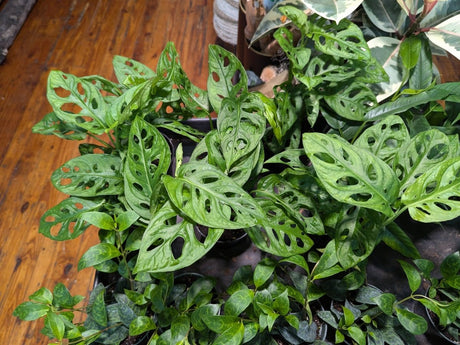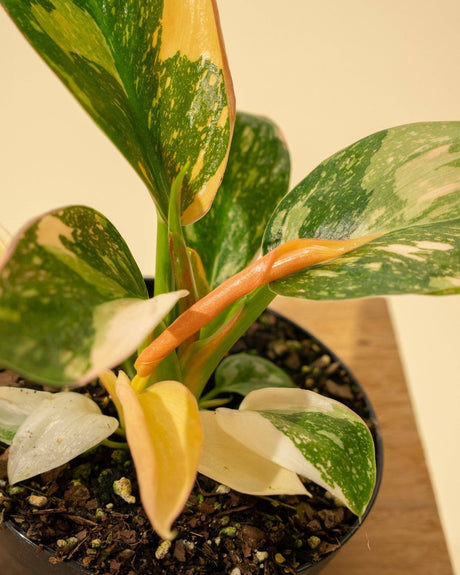A Tropical Showstopper
The Philodendron Burle Marx Variegata (Philodendron Burle Marx variegata) is a rare and captivating tropical plant, celebrated for its stunning yellow-green variegation and natural climbing habit. Native to Brazil, this vibrant aroid thrives indoors with proper care, making it a favorite among collectors and houseplant enthusiasts. Whether trained on a moss pole or allowed to cascade elegantly, this philodendron is an easy-care plant that adds exotic flair to any space.
1. Plant Overview
- Botanical Name: Philodendron Burle Marx albo variegata
- Common Names: Variegated Philodendron Burle Marx, Burle Marx Albo, Burle Marx Variegata, Variegated Burle Marx
- Plant Type: Tropical evergreen, climbing/vining
- Native Range: Brazil
- Mature Size: Can trail or climb several feet indoors
- Toxicity: Toxic to pets and humans if ingested
What Makes It Special?
This variegated philodendron is cherished for its elongated, oblong leaves adorned with unique yellow-green patterns. Its climbing habit and easy-care nature make it a versatile choice for both novice and experienced plant lovers. Whether grown as a statement piece or integrated into a lush indoor garden, it remains a prized addition for any collector.
Closely Related Varieties
There are other philodendrons bearing Roberto Burle Marx’s name, like the non-variegated Philodendron ‘Burle Marx’ and the highly sought-after Philodendron ‘Burle Marx Fantasy.’ While they share a lineage, each has distinct leaf shapes and markings.
2. Light Requirements
- Preferred Light: Bright, indirect sunlight
- Tolerates: Moderate or filtered light
- Avoid: Direct sunlight, which can scorch leaves (especially the lighter variegated parts)
Tip: If you notice the variegation fading or the leaves turning mostly green, try moving your Burle Marx Philodendron to a spot with a bit more bright, indirect light.
3. Water & Soil
Watering Schedule
- Frequency: Water when the top 1–2 inches of soil feel dry to the touch.
- Method: Thoroughly water the plant until water drains out of the bottom of the pot. Discard any excess water in the saucer.
- Overwatering Warning: Leaves turning yellow or mushy stems could indicate root rot—ensure the soil and pot provide good drainage.
Soil Mix
- Ideal Mix: A well-draining, airy potting medium. Combine high-quality potting soil with materials like perlite, orchid bark, or coco coir to boost aeration.
- pH Preference: Neutral to slightly acidic (pH 6.0–7.0).
- Tip: Good drainage is crucial. A mix formulated for aroids or philodendrons is often best. Explore our recommended Houseplant Chunky Mix by Sol Soils or browse our Potting Soil & Substrates collection to find the perfect fit for your plants.
4. Humidity & Temperature
Humidity
- Optimal Range: 40–60% or higher
- Household Air: Generally sufficient, but using a humidifier or pebble tray can help maintain leaf variegation and healthy growth in drier climates.
Temperature
- Ideal Range: 65–75°F (18–24°C)
- Avoid: Sudden temperature fluctuations and cold drafts below 60°F (15°C).
5. Fertilization
Type of Fertilizer
Use a balanced, water-soluble houseplant fertilizer (e.g., 20-20-20 or a similar ratio) or choose specialized plant nutrients from trusted brands like Sol Soils, Arber, or Pepin for optimal growth.
Frequency
- Spring & Summer: Fertilize once a month while the plant is actively growing.
- Fall & Winter: Reduce to every 6–8 weeks, or skip entirely if the plant’s growth slows significantly.
Application
Always follow the product instructions specific to your chosen fertilizer or nutrient solution. For general use, consider diluting the recommended strength by half to prevent over-fertilizing and ensure your plants thrive.
Tip: Signs of over-fertilizing include leaf burn and crusty deposits on the soil surface. Flush the soil with water if you suspect a salt buildup.
6. Pruning & Maintenance
Pruning
Trim away any yellow, brown, or damaged leaves with clean, sharp pruning shears. Prune to maintain size or shape as needed.
Cleaning Leaves
Gently wipe the foliage with a damp cloth to remove dust.
Regular cleaning helps the plant photosynthesize more efficiently and keeps variegation bright.
7. Training & Support
Vining Habit
The Burle Marx Philodendron is celebrated for its natural tendency to trail or climb in its native rainforest habitat. To showcase its full beauty and ensure healthy growth, proper training and support are essential.
Support Structures
Providing a sturdy support structure not only enhances the aesthetic appeal of your Philodendron but also promotes upright growth and larger, healthier leaves. Here are some effective support options:
- Moss Pole: Mimics the plant's natural environment, offering a textured surface for aerial roots to cling.
- Trellis: A decorative and functional option that guides the plant’s growth upward.
- Stake: Ideal for smaller spaces, helping to keep the plant upright without taking up much room.
Shop Support Structures Now ➡️
8. Propagation
Stem Cutting in Water
- Select a Healthy Cutting: Choose a stem with at least one node (the bump where roots and leaves form) and a healthy leaf.
- Cut: Use sterilized pruning shears to make a clean cut just below the node.
- Place in Water: Put the cutting in a clear jar or vase with room-temperature water, ensuring the node is submerged.
- Wait for Roots: After 2–4 weeks, you should see roots forming.
- Transplant: Once roots are an inch or two long, move the cutting into a small pot with well-draining soil.
Stem Cutting in Soil
- Prepare a Small Pot: Fill with a well-draining potting mix (such as aroid mix).
- Make the Cutting: As above, ensure the cutting has at least one node.
- Plant the Cutting: Bury the node about an inch deep into the soil, leaving leaves exposed.
- Humidity & Moisture: Keep the soil slightly moist (not soggy) and maintain higher humidity until roots take hold.
9.Common Pests & Issues
Spider Mites & Mealybugs
Causes: Low humidity and dust accumulation.
Solutions:
- Wipe leaves regularly with a damp cloth.
- Isolate infested plants to prevent spread.
- Apply insecticidal soap or neem oil.
Root Rot
Causes: Overwatering and poor drainage.
Solutions:
- Repot in fresh, well-draining soil.
- Remove and discard affected roots.
- Ensure pots have adequate drainage holes.
Yellowing Leaves
Causes: Overwatering, excessive light, or nutrient deficiency.
Solutions:
- Adjust watering schedule to allow soil to dry between waterings.
- Move plant to a location with appropriate light levels.
- Check and replenish fertilizer as needed.
- Consider using purified water
10. FAQ
1. Can I Grow My Burle Marx Philodendron in Low Light?
Yes, it can adapt to moderate or filtered light. However, if the light is too low, you may lose some of the distinctive variegation, and growth might slow down significantly.
2. Why Are My Plant’s Leaves Turning Brown?
Brown leaf tips or patches could be due to low humidity, underwatering, or direct sun exposure. Check your watering schedule and consider adding a humidifier if the air is very dry.
3. How Often Should I Repot My Burle Marx Philodendron?
Generally, every 1–2 years or whenever the plant becomes root-bound. Choose a pot about 1–2 inches larger than the current one.
4. Is This Philodendron Safe Around Pets?
No. Like most philodendrons, the Burle Marx variety contains calcium oxalate crystals, which are toxic to pets if ingested. Keep it out of reach of cats, dogs, and curious children.
5. What If My Plant Isn’t Producing Variegated Leaves?
Variegation often changes based on light exposure and the plant’s overall health. Make sure your plant receives plenty of indirect light, and avoid pruning off all the variegated sections, as they carry the genetic mutation responsible for its unique coloring. If you can’t provide adequate natural light, consider using a grow light to help maintain vibrant variegation.
11. Final Thoughts
Caring for a Burle Marx Philodendron is straightforward if you understand its tropical origins: warm, moderately humid conditions with bright, indirect light and proper watering practices. By providing these essentials, your variegated leaves will remain vibrant and eye-catching—perfect for any space seeking a touch of exotic flair.
Remember, consistent care yields the best results. Whether you’re a novice houseplant enthusiast or a seasoned collector, following this Burle Marx Philodendron Care Guide will help you grow a healthy, lush plant that truly stands out.
Ready to Add a Rare Beauty to Your Home?


















